Female admiral. Russian classics wrote about the hero of Greece
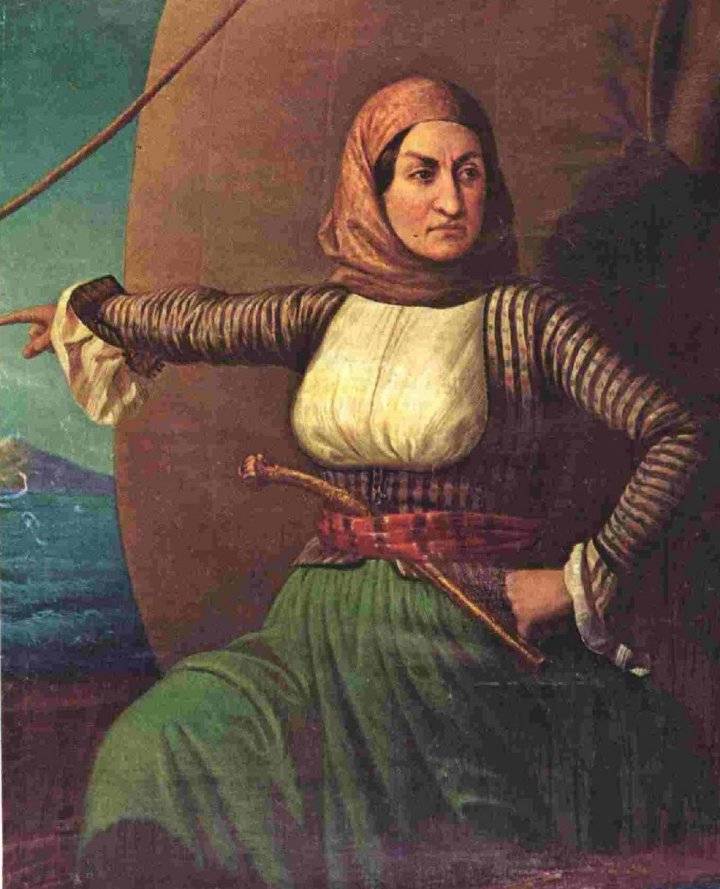
Under the name of Bobelina, the legendary female admiral gained fame in Russia. In fact, her name was Laskarina Bubulina. A Greek woman by nationality, Bubulina became the first and only woman - the admiral of the Russian fleet. She was born 11 in May 1771, in Constantinople, in an Ottoman prison where her parents were imprisoned. The Laskarin family belonged to the Arnauta (Albanian) community of Hydra Island, located near the east coast of the Peloponnese peninsula. The numerous and united Diaspora of the Arnauts - Orthodox Albanians - appeared on Hydra Island in the 15th century, having moved here from the Peloponnese, fleeing from the Ottoman conquest
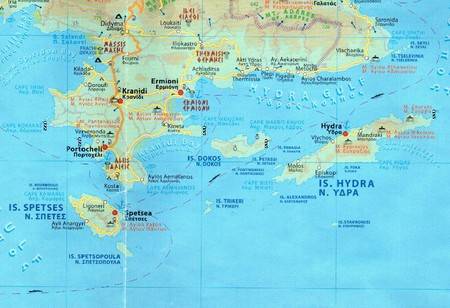
The arnauts, who settled down on the island, became known as the Iriots. They gained fame as excellent sailors, since life itself on the island was convenient for navigation. Arnaut was also the father of Lascarinas, captain Stavrionis Pinocis. He participated in the Greek revolution 1769 — 1770 against Ottoman rule, for which he was arrested and imprisoned in the prison of Constantinople, along with his wife Skevo. However, soon after the birth of his daughter Stavrionis died. After that, the Ottomans released Skevo with her little daughter Laskarina home - on the island of Hydra. Four years later, Skevo was married a second time - to Dimitrios Lazar, and moved to the island of Spetses, where also from the XV century lived an impressive Arnautian community. The childhood years of the future female admiral passed on the island of Spetses. Laskarina grew up in an atmosphere of hostility to the Ottoman conquerors. Specialists, like Idriots, were excellent sailors and most of the men of the island were related to navigation or, at least, to fishing.
At seventeen, Laskarina married for the first time - for Dimitrios Specialties Giannouz. In marriage with him, Laskarins had three children - Yannis, Georgios and Maria. But then Lascarines' husband died. At the age of thirty Laskarina married a second time. Her new husband was the rich shipowner Captain Dimitrios Buboulis, whose last name was Laskarina. In the second marriage, Laskarins had three more children. However, Dimitrios Buboulis was soon killed in a clash with Algerian pirates. After that, the spouse inherited all his fortune and ships. Dimitrios Buboulis was an enemy of the Ottoman Empire, participated in the Russian-Turkish war on the side of the Russian Empire and fell at the hands of the Algerian pirates, therefore Laskarina considered it her duty to continue the work of her husband and strengthen the Greek fleet. At her own expense, she built an eighteen-cannon corvette "Agamemnon". The Ottoman authorities were interested in the activities of Bubulina, who tried to confiscate the property of a rich shipowner.
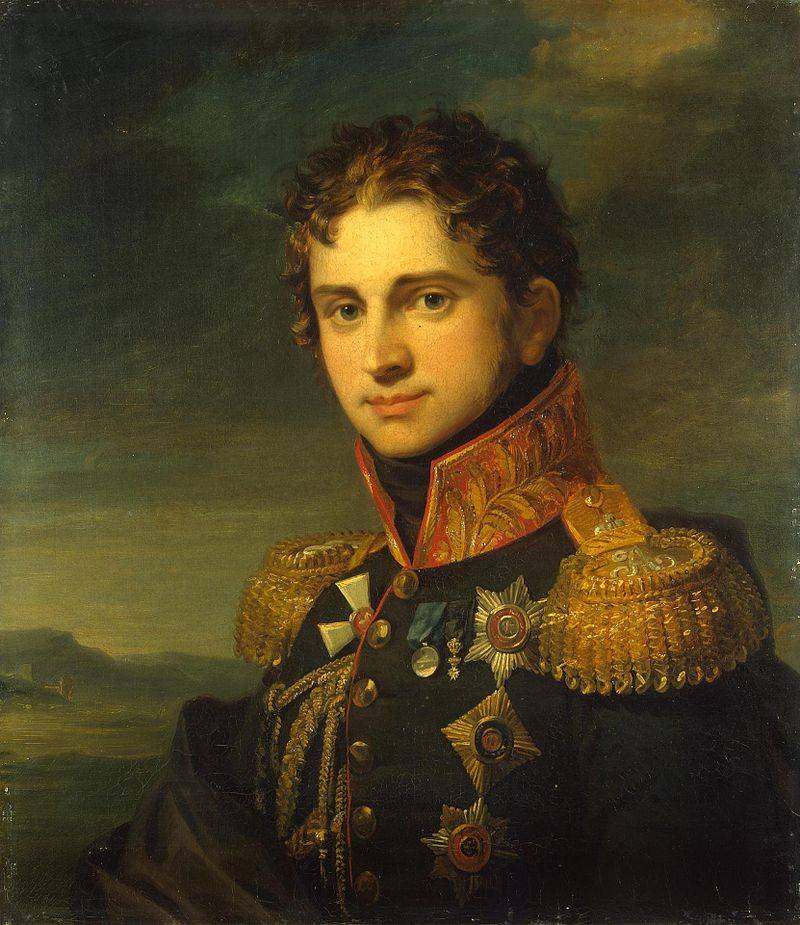
The ambassador of the Russian Empire in Constantinople, Count Grigory Alexandrovich Stroganov (1770-1857), in 1816-1821, came to the aid of Laskarin. who headed the Russian diplomatic mission in the Ottoman Empire. He transported Lascarin Bubulin to the Crimea, where the Greek patriot spent about three months, until the passions subsided. She then returned to the island of Spetse, where she continued to strengthen her own small fleet. Impressive state allowed Laskarine Bubulin not only to keep the ships with the crews, but also the armed formations of the Greek rebels. She became one of the main sponsors of the underground organization of the Greek patriots Filiki Eteriya, the Society of Friends. It was founded by 14 September 1814, the Greek patriots, who were at that time in Odessa.
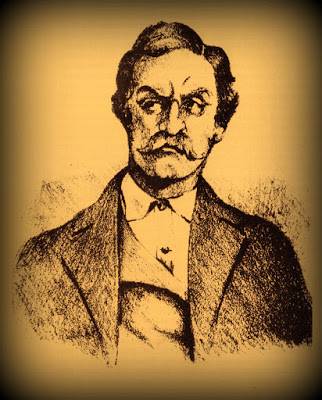 The most important figures in the first stage of the Society of Friends were the artisan Nikolaos Skufas (1779-1818, in the portrait) - a native of the village of Kompoty in Epirus (region on the border of Greece and Albania), who made the caps, Emmanuel Xantos (1772-1852) - originated from Patmos Islands, an employee of a trading company based in Odessa, and Tsakalof Atanasios (1790-1851) - also came from Epirus, who moved to Russia as a youth.
The most important figures in the first stage of the Society of Friends were the artisan Nikolaos Skufas (1779-1818, in the portrait) - a native of the village of Kompoty in Epirus (region on the border of Greece and Albania), who made the caps, Emmanuel Xantos (1772-1852) - originated from Patmos Islands, an employee of a trading company based in Odessa, and Tsakalof Atanasios (1790-1851) - also came from Epirus, who moved to Russia as a youth. "Filiki Eteriya" set as its goal the liberation of Greece from Ottoman rule. The Society of Friends was modeled on the Carbonari groups and was distinguished by strict discipline and hierarchy. The governing body was the "Invisible Power", which included three founders - Skoufas, Xanthos and Athanasios. After the death of Nikolaos Skuphas in 1818, who fell ill and died in Constantinople, five more people were included in the leadership of the Society of Friends, then three more. In the end, 12 "apostles" took charge of the organization. Each of the "apostles" was responsible for organizing resistance in a certain area of Greek territory. The bulk of the members of the society were Greek merchants, employees and representatives of the clergy. However, the higher hierarchs of the church refused to participate in "Filiki Eteriya". In April 1820 of the Year, the Society of Friends elected Alexander Ypsilanti (1792-1828), Major General of the Russian service and participant of the Patriotic War 1812, as their captain-general.
Laskarina Bubulina launched a stormy activity in preparation for an armed uprising against the Ottoman Empire. She organized the secret supply to the island of Spetse building materials and weapons for their ships. The real pride of the specialties was the corvette “Agamemnon”. Bubulina paid a lot of money to Turkish officials to ignore the size of this ship. Thus, thanks to the efforts of this woman, a sufficiently powerful rebel fleet was formed. 13 March 1821 of the Year Bubulina raised her own Greek flag on the ship Agamemnon, created on the basis of the flag of the Byzantine imperial dynasty Komnins.
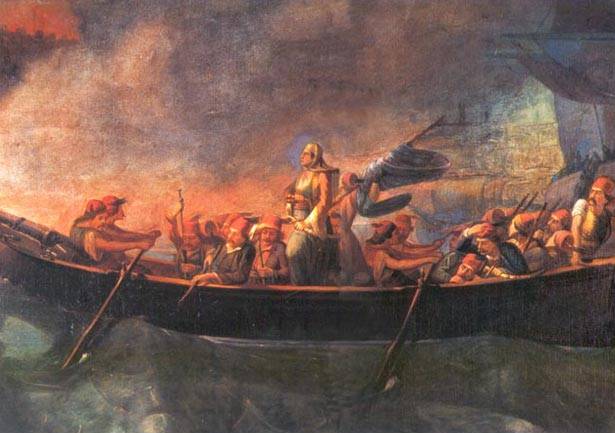
March 25 (April 6) An anti-Ottoman uprising flared up in Greece on 1821. It began in the city of Areopolis and soon spread to the entire territory of the Peloponnese, and then to the whole of mainland Greece. The rebel detachments quickly gained impressive numbers and the Turkish garrisons were forced to lock themselves in the fortresses, losing control of the Peloponnese territory. The most important role in the uprising was played by the Greek islands - Hydra, Insar and Spetses, where the Orthodox Arnauts and Greeks who lived on hated the Ottoman government. It is the islanders who constituted the core of the Greek rebel fleet. At the disposal of the rebels were more than 80 ships, much of which was equipped with Lascarin Bubulina funds. On the armament of the rebel fleet, she spent almost all his condition. The Laskarins' money was equipped by her own army, equipped with specialties - people from the island of Spetses, excellent warriors and sailors. The task of connecting the inhabitants of Hydra Island to the uprising, also excellent sailors, turned out to be far more problematic.
However, it is worth noting that many wealthy idriots did not welcome the participation of the islanders in the uprising. Of the 28 thousands of inhabitants of the island of Hydra, 10 of thousands, that is, almost all men, were sailors. But the elders and the largest shipowners had a real influence on the island (most often, they were the same people). They tried to resist the desire of the ordinary Idriots to oppose the Ottomans. As a result, the sailors, led by A. Iconom, rebelled against the shipowners, after which the ships of the Hydra joined the fleet of the island of Spetses, which by that time had already fought with the Ottomans. Since Hydra Island possessed 120 armed ships, its joining the rebellion also made a major contribution to the success of the Greek patriots.
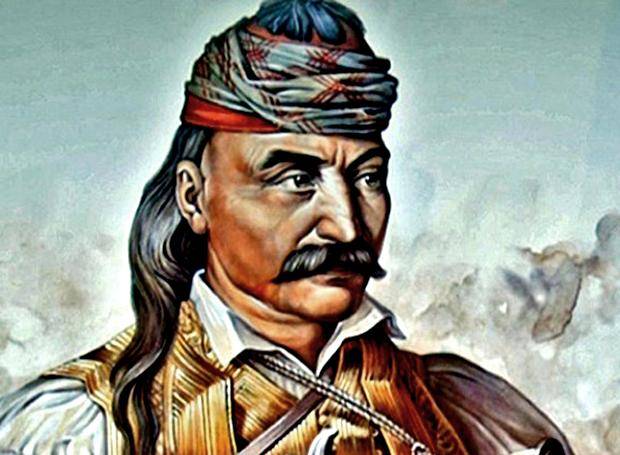
An elderly woman (in 1821, Laskarine was fifty years old), Bubulina showed miracles of courage by personally participating in the battle under the fortress of Nafplion - one of the most strategically important fortified points of the Ottoman Empire in the Peloponnese. In the battle of Nafplion Laskarina, Bubulina commanded the rebel flotilla ship. Bubulina then participated in the naval blockade and the capture of Monemvasia and Pylos. In May 1821, the son of Bubulina, Yannis Giannuza died in the battle of Argos. In September, Bubulina 1821 arrived in the Greek city of Tripolis, where the Theodoros Kolokotronis (1770-1843) detachments, the renowned “captain” of the Kleft squad, acted (cleft - Greek rebels, gayduk analog). The liberated Tripolis captain Kolokotronis was a valiant warrior, but he had his own ideas about how the Greek army should be organized. For the son of Kolokotronis Panos Kolokotronisa, the daughter of Laskarina Bubulina Elena Bubulina married. The time of the liberation of Tripolis includes the noble deed of Laskarins - with its authority it saved most of the women and girls who performed economic functions in the Ottoman garrison of the city from mockery and reprisals.
When Nafplion was liberated from the Ottoman occupation, Bubulina settled in this city. However, the victory of the rebels did not bring peace to the Greek land. Almost immediately, disagreements began between the rebel commanders, leading to a civil war. The son-in-law of Bubulina Panos Kolokotronis was killed in internecine struggle, and Theodoros Kolokotronis was arrested and imprisoned. Bubulina, who had family and kinship ties with Kolokotronis Sr., appealed to the Greek government to release the honored captain of kleft. However, with this appeal she made herself worse only to herself - the Greek leadership considered Bubulina’s act dangerous for the state system. The woman was arrested, though soon released. After this speech, Bubulins confiscated the estate issued to her in Nafplion and sent them back to the island of Spetses. This award was given to the legendary heroine of the national liberation struggle from the national government.
While Bubulin lived on the island of Spetses, the Ottoman Empire attempted to prevent the final liberation of Greece. February 12 The Egyptian admiral Ibrahim Pasha landed on the Peloponnese in the port of Pylos on the Peloponnese with an 1825-thousandth armed detachment. Bubulina began preparations for a new appearance at the head of the ships against the Ottoman flotilla. And it was at this very inopportune moment that the life of the admiral woman was interrupted by a ridiculous and tragic incident. The legendary warrior, who often risked herself in naval battles, died in a banal domestic conflict.
The youngest son of Lascarines Bubulina from his first marriage, Georgios Giannuza, fell in love with Evgeny Kutsis, the daughter of one of the richest inhabitants of the Spetzé island, Christodoulos Kutsis. This man was an elder Spetses and, despite the fame of Bubulina, he did not really want his daughter's marriage with her son, since the admiral had already spent her entire fortune. However, the hot Greek guy Georgios Giannuza decided to abduct Eugenia. Together with Eugenia, he arrived at the house of his late father Dimitrios. Laskarina Bubulina soon arrived there. Meanwhile, according to the customs of the island of Spetses, the abduction of the girl was considered a great insult to her parents' family and was equated with rape. Enraged Christodoule Kutsis and his relatives and members of the household arrived at the house of Giannuza. The quarrel began, which grew into a fight. At one point, Yannis Kutzis shot Laskarina Bubulin with a pistol. The bullet hit right in the forehead. A female naval commander died instantly. So ended her amazing life - in a ridiculous quarrel over the reason of "personal hostility", as they would say in our time.
- a monument to the admiral woman
After the death of Laskarina Bubulina, the corvette “Agamemnon” was transferred to the navy of Greece and until the 1831 of the year served as the flagship under the new name - “Spetse”. In 1831, he was burned at a base in Poros during another civil war. As for Laskarina herself, the streets in different cities of Greece were named after her, and on the island of Spetses there is a monument to the legendary heroine of the national liberation struggle and there is her museum.
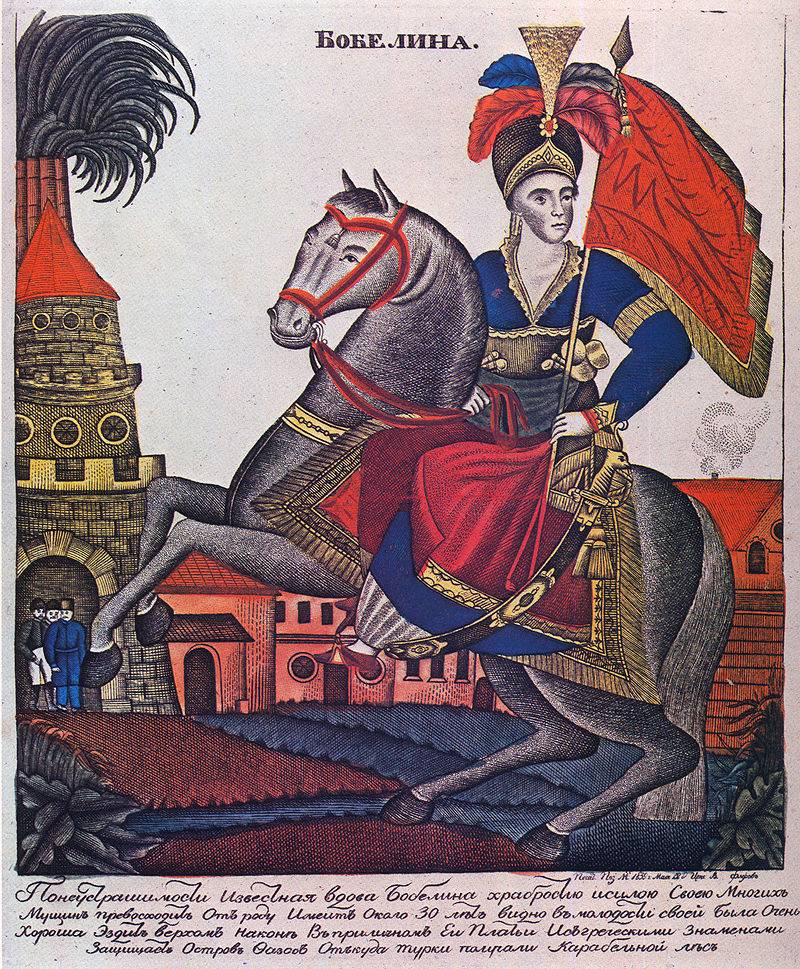
The glory of the woman - the commander of the ship spread far beyond Greece. Bubulin received especially great popularity in the Russian Empire. Emperor Alexander I awarded the rank of admiral of the Russian fleet to a woman naval commander. In Russian literature and painting Laskarina Bubulina gained fame under the name "Bobelina". The heroes of the struggle for the liberation of Greece in the first half of the XIX century were generally very popular in Russia - they sympathized with them as Orthodox brothers in the faith, and the most advanced part of the nobility considered Greek patriots to be role models as fighters against tyranny. The first images of "Bobelin" represented her almost exclusively on horseback - as a woman rider. About "Bobelin" in the works or letters mentioned not only N.V. Gogol, but also V.G. Belinsky, I.S. Turgenev, G.N. Danilevsky, N.S. Leskov.
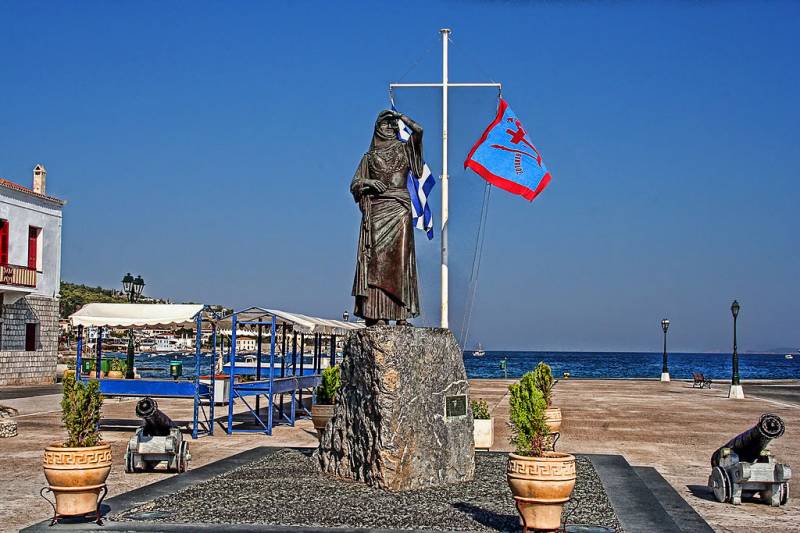
Information